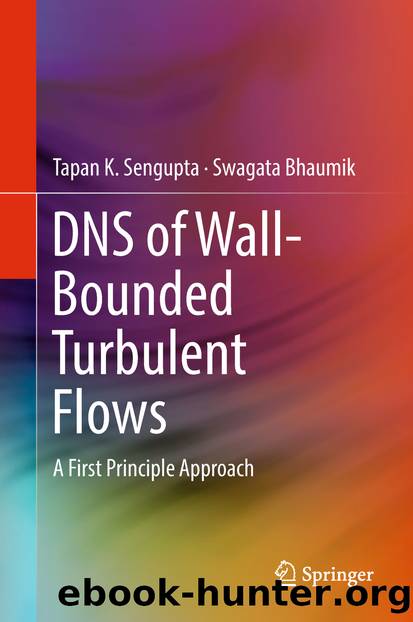DNS of Wall-Bounded Turbulent Flows by Tapan K. Sengupta & Swagata Bhaumik

Author:Tapan K. Sengupta & Swagata Bhaumik
Language: eng
Format: epub
Publisher: Springer Singapore, Singapore
3.7 Equilibrium Solution for Mixed Convection Flows: Isothermal Wall Case
In [42] the formulation used in [49] has been generalized for flow past isothermal wedge. This flow does not exhibit singular heat transfer at the leading edge. The governing equation transforms to ordinary differential equation for the external flow given by , with the new independent variable, . The wall temperature distribution is given by . The choice of provides a wall-temperature distribution which is independent of X, which corresponds to a wedge angle of . Despite similarity, flow and heat transfer at the wall are completely different in [42], as compared to that in [49]. However, as the boundary layer edge velocity in [42] is a function of X, none of these velocity profiles directly represents similar solution. Both these flows are considered to study spatial and temporal viscous instabilities by solving NSE with different heat transfer at the wall, and help identify the active instability mechanisms for mixed convection flows.
Heat transfer modeled by Boussinesq approximation for mixed convection flows induces pressure gradient of the equilibrium flows. Such mean flows display flow instabilities, including inviscid instability, similar to that given by Rayleigh’s equation for flows without heat transfer [19, 53]. This is shown here and new theorems stated with necessary conditions for temporal instability by linear inviscid mechanism. Also DNS of flows with heat transfer are provided, which show viscous and inviscid mechanisms simultaneously. In such a scenario, it is essential that we show predominance of one mechanism over the other.
The wedge flow given in [42] is a general equilibrium flow. In defining the governing equations for mixed convection flows, a buoyancy parameter is introduced as in [42] and K in [49], these symbols will be used here as and , respectively, with the subscript indicating isothermal and adiabatic conditions for flow over the general wedge flow defined as,
Download
This site does not store any files on its server. We only index and link to content provided by other sites. Please contact the content providers to delete copyright contents if any and email us, we'll remove relevant links or contents immediately.
| Biomathematics | Differential Equations |
| Game Theory | Graph Theory |
| Linear Programming | Probability & Statistics |
| Statistics | Stochastic Modeling |
| Vector Analysis |
Modelling of Convective Heat and Mass Transfer in Rotating Flows by Igor V. Shevchuk(6391)
Weapons of Math Destruction by Cathy O'Neil(6142)
Factfulness: Ten Reasons We're Wrong About the World – and Why Things Are Better Than You Think by Hans Rosling(4694)
Descartes' Error by Antonio Damasio(3230)
A Mind For Numbers: How to Excel at Math and Science (Even If You Flunked Algebra) by Barbara Oakley(3217)
Factfulness_Ten Reasons We're Wrong About the World_and Why Things Are Better Than You Think by Hans Rosling(3199)
TCP IP by Todd Lammle(3134)
Fooled by Randomness: The Hidden Role of Chance in Life and in the Markets by Nassim Nicholas Taleb(3044)
Applied Predictive Modeling by Max Kuhn & Kjell Johnson(3018)
The Tyranny of Metrics by Jerry Z. Muller(3000)
The Book of Numbers by Peter Bentley(2908)
The Great Unknown by Marcus du Sautoy(2646)
Once Upon an Algorithm by Martin Erwig(2598)
Easy Algebra Step-by-Step by Sandra Luna McCune(2581)
Lady Luck by Kristen Ashley(2532)
Practical Guide To Principal Component Methods in R (Multivariate Analysis Book 2) by Alboukadel Kassambara(2497)
Police Exams Prep 2018-2019 by Kaplan Test Prep(2483)
All Things Reconsidered by Bill Thompson III(2355)
Linear Time-Invariant Systems, Behaviors and Modules by Ulrich Oberst & Martin Scheicher & Ingrid Scheicher(2333)
